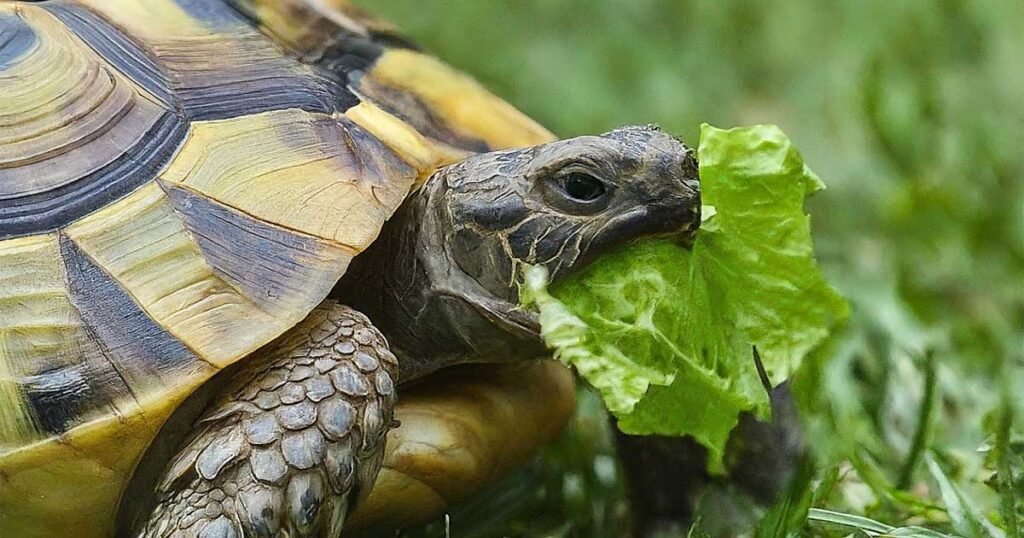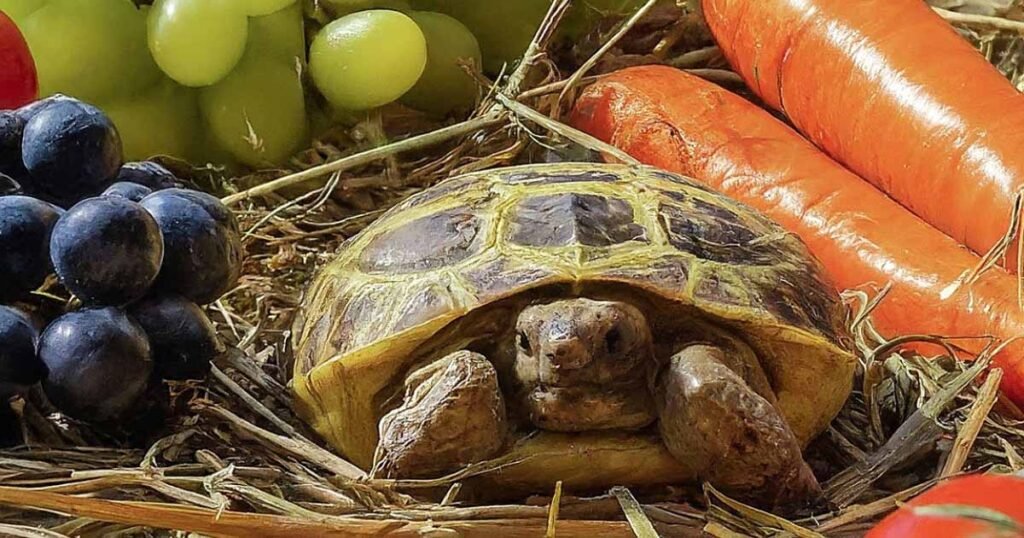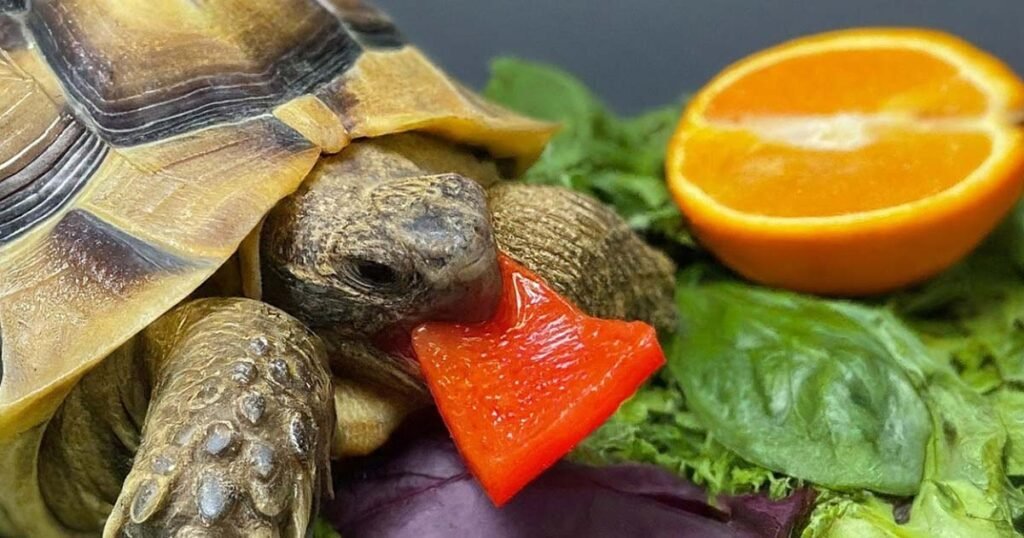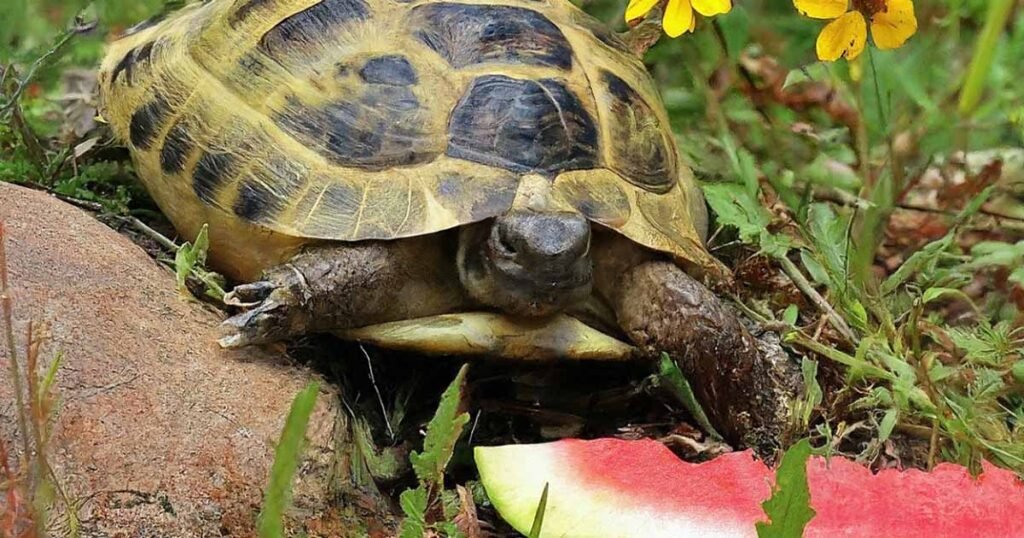There are around 356 turtle species living worldwide. Russian turtles, mainly tortoises, are one of them. The Russian turtle is a species from Asia that can adapt to any climate. If you are a new Russian turtle owner, then you can have this question: “What Do Russian Turtles Eat?” Well, Russian turtles are mainly herbivores. Their primary diet consists of leafy greens and veggies, with occasional fruits.
An herbivore diet consists mainly of plant-based foods, which seems the healthiest option. Being a responsible pet owner, you should know what kind of veggies to give them and how much to provide them with. It is because not all vegetables and fruits are equally healthy for them. So, let’s take a look at what Russian Turtles eat.
What Do Russian Turtles Eat?

Russian turtles are herbivore eaters, as we mentioned above. As a herbivore, Russian turtles love to savor different types of leafy greens, vegetables, and fruits. Also, especially made for turtles, pellets can be served sparingly as a supplement to fulfill their lack of nutrition.
Russian Tortoises & Their Diet

Russian tortoises, also known as Afghan tortoises or Horsfield’s tortoises. They are popular pets known for their lively personalities and distinct appearances. The scientific name for a Russian tortoise is actually Testudo Horsfieldii or Agrionemys Horsfieldii.
Interestingly, they have several different scientific names, but these two are the most commonly used. These herbivore tortoises live in Asia’s high mountains, some as high as 7,000 feet. In their natural habitat, they eat a variety of plants rich in fiber and calcium.
These lively little charmers were discovered as pets in 1966. For their engaging personalities that have won over countless tortoise pet owners.
Herbivore Diet
The Russian tortoise is a plant-loving creature with specific diet needs. Russian tortoises are herbivores and prefer various leafy greens and fruits or vegetables. Their diet habits match their natural diet. You can think of them as tiny salad fans!
They particularly enjoy mustard greens, turnip greens, and dandelion greens, which provide essential nutrients for their growth and vitality.
What Types of Food Russian Turtles Eat

Russian tortoises might seem like tiny trash compactors, but these shelled friends actually have specific dietary needs. As herbivores, they get their energy from plants, not meat or processed foods. There are mainly four main types of food that fall into their diet: Vegetables, Fruits, Pellets (made for turtles), and Processed food (contains preservatives and chemicals)
Let’s explore their delicious diet to find out what keeps them healthy –
Veggie Delights
Veggies are a cornerstone of a Russian tortoise’s diet. Think of them as tiny salad connoisseurs who particularly enjoy dark, leafy greens like:
- Mustard greens
- Turnip greens
- Dandelion greens
- Collard greens
- Kale (in limited quantities)
You can also offer chopped vegetables for a balanced and colorful plate, such as:
- Carrots
- Bell peppers (red, yellow, orange)
- Squash (butternut, acorn)
Fruity Treats
Fruits can add a touch of sweetness and variety to your Russian tortoise’s diet. However, remember, these are treats, not staples. Sugary fruits like grapes or bananas should be offered sparingly. Instead, focus on fiber-rich options like:
- Strawberries
- Melons (except watermelon)
- Chopped apples
- Berries (raspberries, blueberries)
Important Note: Always wash fruits and vegetables thoroughly before offering them to your tortoise.
Turtle Pellets
The majority of processed foods aren’t suitable for Russian tortoises, but there is one exception: pellets explicitly formulated for tortoises. You can consider them vitamin-packed snacks.
These are handy if you’re worried that your tortoise’s fresh food diet might be lacking in some vitamins and minerals. However, pellets should be a supplement, not the main course.
Remember: Talk to your veterinarian about the right type and amount of pellets to offer your Russian tortoise, as their needs can vary depending on age and health.
Skip the Processed Stuff: Why It’s a No-Go
You might feel like sharing your snacks with Russian tortoises but don’t do it. Processed foods like cheese, chips, or sugary cereals are a big no-no for these little herbivores. These foods are often high in sugar, fat, and salt, which can cause health problems for your tortoise.
Think of it this way – you wouldn’t give your dog a giant chocolate bar, right? The same goes for processed foods and your tortoise. Stick to a diet of fresh fruits, veggies, and specially formulated pellets for a happy and healthy-shelled friend.
How Much Vegetables to Include in the Russian Turtle Diet?

Now that you’ve seen the delicious world of Russian tortoise food, you might think- how much of each yummy option should they actually eat? Here’s a breakdown to help you create the right plate for your little shelled friend:
Vegetables
Vegetables should be the star of the show, making up about 70% of your Russian tortoise’s diet. They provide essential vitamins, fiber, and water to keep your tortoise healthy and thriving.
Fruity Treats
Fruits can add sweetness and variety, but remember, they’re treats, not staples. Offer them sparingly, so they only make up for a small portion (approximately 10-15% ) of your Russian tortoise’s overall diet. Too much sugar can be unhealthy for them.
Pellet
Tortoise pellets provide your pet with all the nutrition they need, especially if their fresh food diet is lacking, as we already told you above. Pellets should make up the remaining 15-20% of your tortoise’s diet.
Foods to Serve in Moderation to Your Russian Tortoise
While there’s a whole world of delicious options for your tiny herbivore, some veggies and fruits can be harmful. Here’s a quick guide to skipping tummy troubles and serving these vegetables in moderation for Russian Turtles :
Iceberg Lettuce: It might look appealing, but iceberg lettuce offers little to no nutritional value for your tortoise.
Cucumbers: Similar to iceberg lettuce, cucumbers are mostly water and lack essential nutrients.
Eggplant: While humans enjoy eggplant, Russian tortoises can have digestive problems.
Mushrooms: Wild mushrooms can be difficult for tortoises to digest and may even contain toxins.
High-Phosphorus Veggies: Be mindful of vegetables high in phosphorus, which can interfere with calcium absorption. You have to serve these veggies in balance:
- Tomatoes
- Asparagus
- Carrots (in large quantities)
- Beets
- Bell pepper
- Turnips
- Pumpkin
- Green Beans (in large quantities)
- Cauliflower
- Corn
- Brussels Sprouts
- Squash (in large quantities)
- Broccoli
- Sweet potatoes
- Romaine Lettuce
Fruits
Sugary Fruits: Fruits like grapes, bananas, and dried fruits are high in sugar, which can lead to weight gain and health problems for your tortoise.
Citrus Fruits: The citric acid in fruits like oranges, lemons, and grapefruits can irritate your tortoise’s stomach.
Avocado: Avocados contain persin, a toxin that can be harmful to tortoises.
Stone Fruits: While peaches, plums, and nectarines might seem tempting, the pits contain cyanide, which is poisonous to tortoises.
Other Fruits to Avoid:
- Raisins
- Prunes
- Dates
- Guava
- Coconut
- Kiwi
- Persimmon
- Cantaloupe
- Apricot
- Pomegranate
- Honeydew
- Mulberries
When in doubt, leave it out. It’s better to avoid a particular fruit or vegetable if you’re wondering if it’s safe for your Russian tortoise.
Feeding Tips for Russian Tortoises
Now, let’s look at some of the primary feeding tips for your Russian turtle –
- Fresh Food Matters: Offer fresh food once or twice daily, such as chopped vegetables, dark leafy greens, and occasional fruits.
- Portion Control is Key: Start with a moderate amount and adjust based on your tortoise’s age, activity level, and individual needs. Talk to your vet for specific recommendations.
- Variety is the Spice of Life: A mix of vegetables, greens, and occasional fruits ensures a balanced diet.
- Safety First: Chop fruits and veggies into bite-sized pieces to prevent choking. Wash everything thoroughly to remove dirt or pesticides.
- Hydration Station: Provide a shallow dish of clean, fresh water at all times.
- Cleanliness Counts: Regularly clean food and water dishes to prevent bacteria growth.
- Vet Chat: Discuss your tortoise’s diet with your veterinarian for personalized advice.
Here’s a brief overview of two feeding methods used for Russian tortoises
(Please note: This information is for informational purposes only. Consult a veterinarian for feeding recommendations for your tortoise):
- 15-Minute Method: This method involves offering a large amount of food and allowing the tortoise to eat for 15 minutes before removing it.
- Head-Size Method: This method suggests providing a portion of food roughly the size of the tortoise’s head (excluding the neck).
FAQs
What do Russian box turtles eat?
Russian box turtles are herbivores and love a colorful plate of vegetables and fruits. Consider chopped veggies, dark leafy greens, and the occasional fruit treat for their diet. Talk to your vet for specific feeding advice.
What do Russian land turtles eat?
These tiny Russian land turtles eat a variety of veggies and dark, leafy greens. Occasional fruits are okay for a touch of sweetness. But make sure you are serving the right balanced meal for their happy health.
What do Russian turtles like to eat?
Russian turtles are herbivores, so they mostly like vegetables and fruits. They do not prefer meat meals like carnivore turtles. However, you can also include turtle pellets for Russin turtles as a supplement.
Read More: Do Turtles Eat Slugs?
Bottom Line
Are you now aware of what Russian turtles eat? It turns out they love salad and sweet things, too. They prefer a colorful plate filled with fresh veggies, leafy greens, and the occasional fruity treat. Remember, though, these are just general guidelines.
Every tortoise is individual, so consult with your vet to create the appropriate feeding plan for your tiny herbivore companion.
